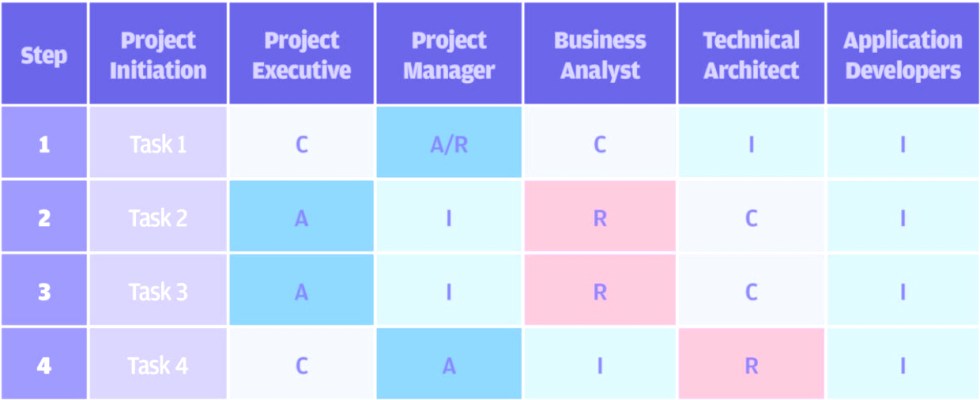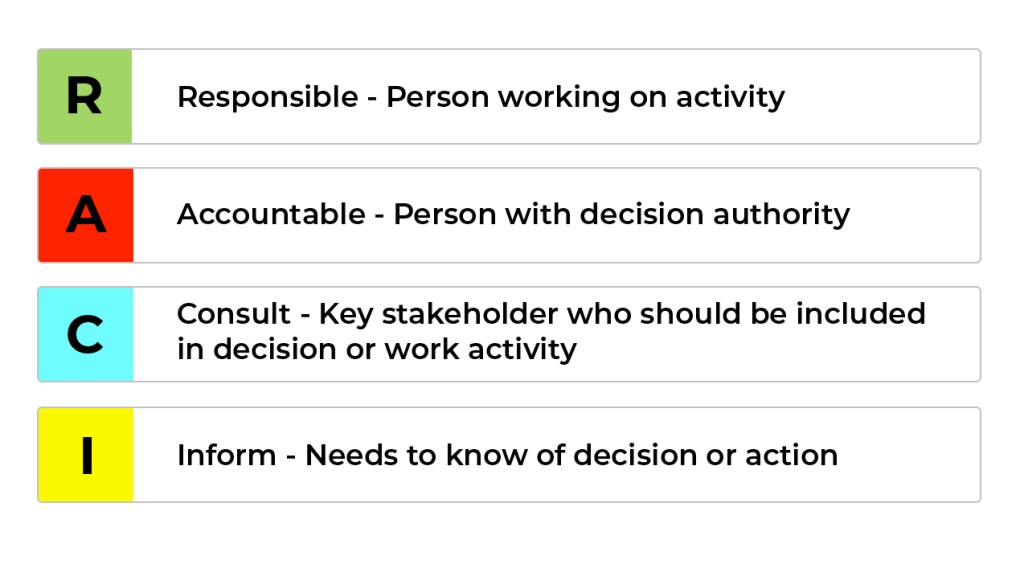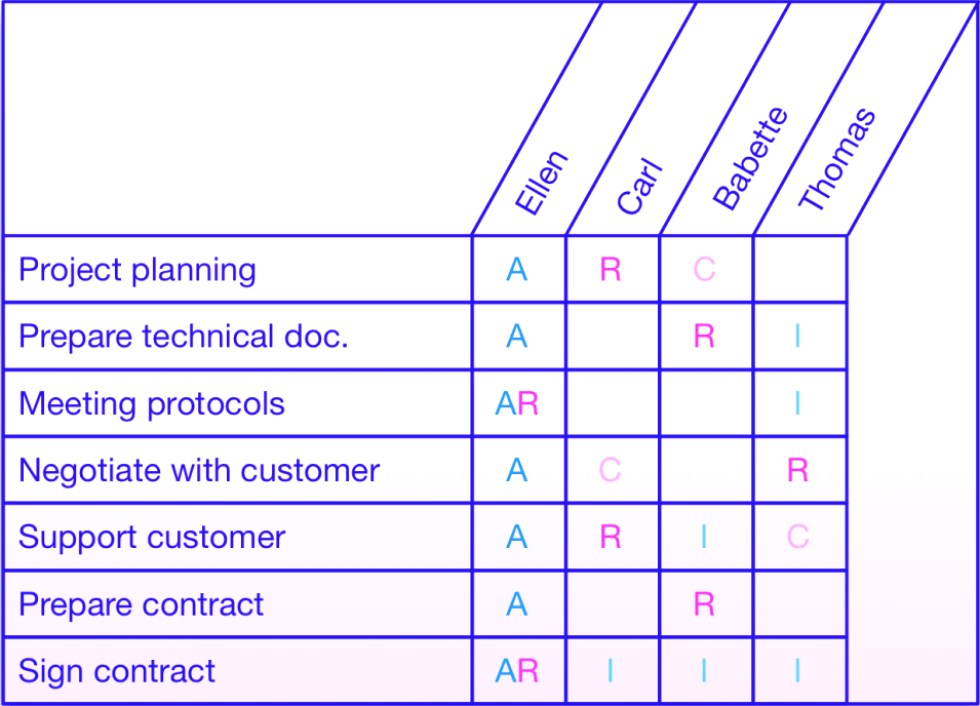Project Management Guide
Project Management Guide
What Is Project Management?
What Is a Project?
Why Is Project Management Important?
Project Life Cycle Phases
- Project Initiation
- Project Planning
- Project Execution
- Project Monitoring
- Project Closure
Project Management Methodologies
- Waterfall Project Management
- Critical Path Method
- Critical Chain Project Management
- Agile Project Management
- Scrum Project Management
- Kanban Project Management
- Lean Project Management
- Six Sigma Project Management
- PRINCE2
- PRiSM
- PMBOK Method
Project Management FAQ
What is a RACI Chart in Project Management?
When you are dealing with a complex project, it is tough to keep a tab on all activities. No matter how vigilant you are, there are things that may fall through the cracks and eventually contribute to a project’s failure! Fortunately, a RACI chart in project management is a tool that is designed to help dodge the pitfalls that could come in the way.
In this post, we will start with the RACI chart definition and understand the concept through real-life examples.
What is a RACI Chart?

Let’s start with the basic RACI chart definition.
RACI chart is a simple matrix that allocates roles and responsibilities to each team member. By mapping the deliverables against the agents, it ascribes accountability for every task, decision, and milestone at every stage of the project. As a result, the project manager has a grasp of who is doing what, which eliminates any kind of confusion that may pose as roadblocks.
Since a RACI chart is an acronym, its meaning can be further elaborated through its expansion, which is:
Responsible: Who is doing the task?
An individual who is responsible for the task is entrusted with carrying out all the work or making all the decisions for the said task. Ideally, it is preferred to have only one Responsible person per task or deliverable. However, in some cases, you may have more than one person involved.
Accountable: Who owns the task?
Someone who is held Accountable is responsible for the overall completion of the task or deliverable. It means that they have to do everything from delegating the task to reviewing it upon completion. And while every task has an Accountable authority, these do not have to necessarily be the project manager.
Consulted: Who is offering inputs or assisting the task?
In this position, the individual, group, or team occupies a consultative role. Quite often, the entities making recommendations or sharing inputs are subject matter experts who offer guidance, share feedback, or assess the future impact of the task or deliverable. Consultants engage in two-way communication with the Responsible and Accountable authorities at various stages.
Informed: Who should be made aware of the task progress?
These are the team members who require constant updates regarding the project’s progress. Depending on the project’s size, they may also be involved at the task or deliverable levels where you need to keep them in the loop regarding the status and the progress of each element. Such communications flow in a single direction, that is, from the Responsible/Accountable to the Informed.

When Should You Use a RACI Chart?
A RACI chart can fit almost all applications within project management. However, it may be more useful in certain instances and settings than the others. Here is a summary of the best scenarios where you can use a RACI chart, according to PMP:
- Where the tasks require multiple resources at the same time.
- When one task or deliverable is dependent on the outcome of another task or deliverable.
- Where the decision-making or approval process could put the project on hold.
- When there is conflict surrounding task ownership.
- When the project load is not equally distributed.
- When the team witnesses employee turnover and requires the onboarding and orientation of new members.
You can skip the process of creating a RACI chart template if the project is small or when your teams can seamlessly communicate and collaborate with each other.
Benefits of Using a RACI Chart in Project Management
The advantages of using a RACI chart in project management are as follows:
- By setting clear expectations right at the beginning of the project, a RACI chart lays the foundation for its efficiency and imminent success.
- Project managers can prioritize and streamline communications to make them more effective and expeditious.
- Since a RACI chart clearly defines the roles and responsibilities of every individual, it avoids the over-involvement of people and the subsequent overload.
- Having a high-level overview of the project prevents and contains burn-out at any stage.
- The use of RACI chart excel template also removes any data silo and sets the stage for seamless collaboration.
- Since a RACI chart introduces transparency, it encourages individuals to take responsibility and accountability for their work.
Steps for Creating a RACI Chart: Example and Templates

Creating a RACI chart for PMP is a straightforward, 3-step process:
- List out the project roles or names of the stakeholders in the first row.
- Enter the tasks, decisions, and milestones in the first column.
- Assign a RACI chart (R/A/C/I) value against the individual or a team for every task.
And just like that, you have a basic RACI chart template. You can elaborate on it further and make it more granular to your liking. Alternatively, you can even acquire a high-level view to minimize distractions.
Based on the RACI chart excel template shared above, here is a quick RACI chart example for building a house:
| Homeowner | Architect | Construction Manager | Contractor | |
|---|---|---|---|---|
| Plan Reviews | R | A | C | I |
| Budget Estimate | A | C | R | A |
| Obtain Permits | I | C | R | R |
| Site Preparation | I | I | A | R |
| Exterior | I | C | R | R |
| Interior | I | C | R | R |
| Final Review | R | C | A | A |
Concluding Thoughts
A RACI chartoffers structure, definition, and direction to your project. It allows project managers to review every intersection of the tasks involved in the completion of a project and identify the individuals involved in the activity or its decision-making. RACI chart plays a crucial role in defining the role conception, role expectation, and role behavior at every stage of project development.
At the same time, it eliminates any bias, personality issues, or politics from getting in the way of productivity. You can use it as a glue that binds all the stakeholders, brings them on the same page, and motivates them to work towards a common goal. As a result, you can deliver fail-proof results in all projects at all times!
